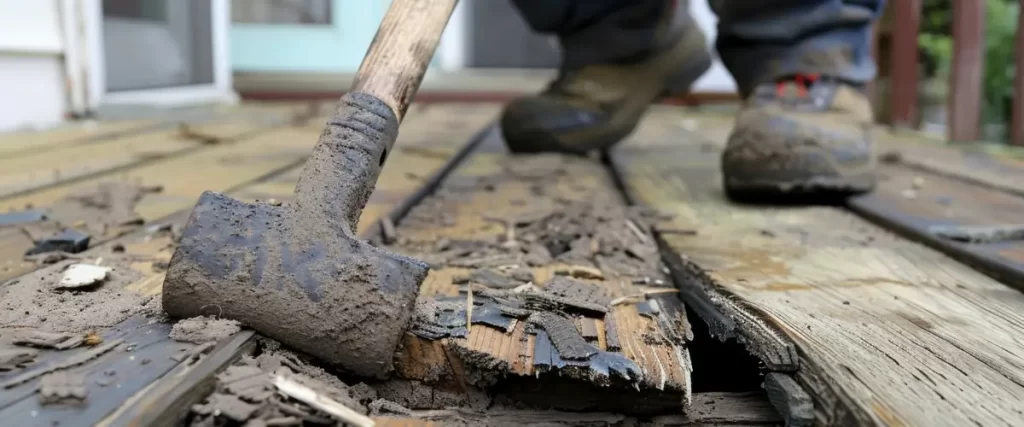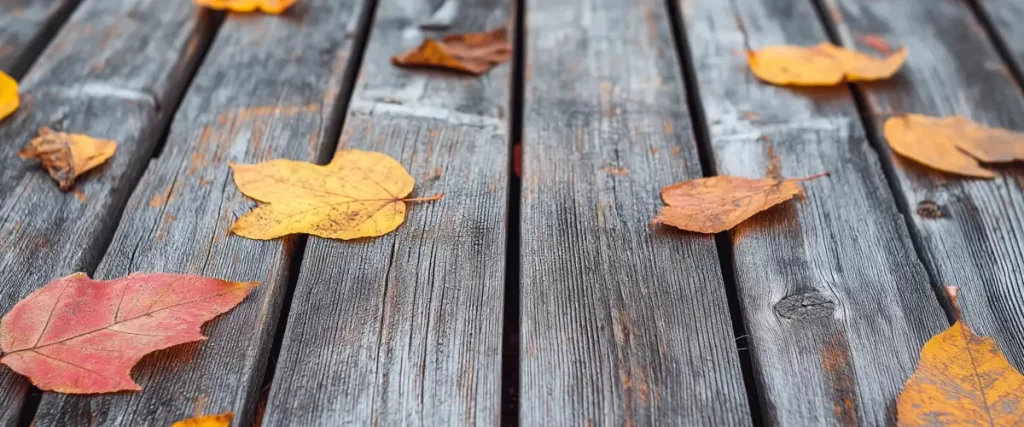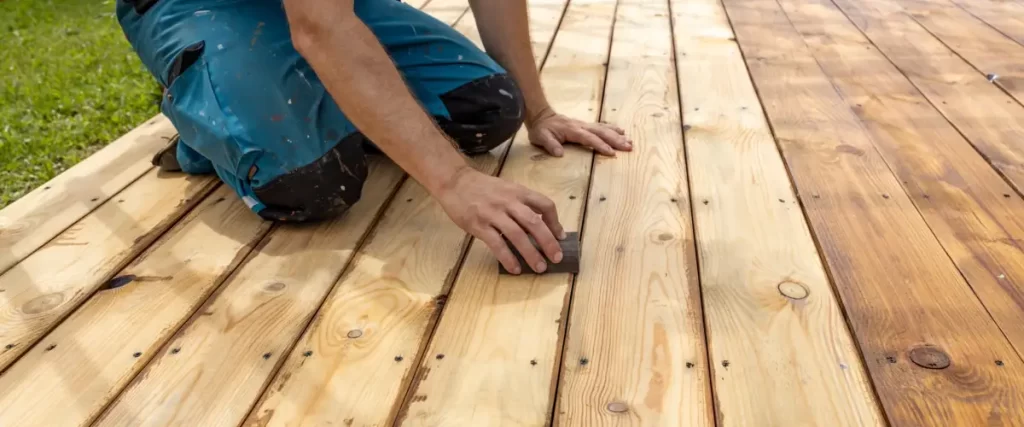To keep your deck in great shape it’s crucial to prevent deck rot. One of the biggest threats to your deck’s health is rot. Whether it’s dry rot or general decay, once it sets in, it can cause serious damage to your deck boards, deck joists, and even the entire structure. But don’t worry – preventing deck rot is easier than you might think if you follow the right steps.

What Is Deck Rot?
Deck rot, especially dry rot, is a type of decay caused by fungi that thrive in moist environments. It weakens the wood, making it soft and crumbly. If left untreated, it can spread across the deck’s timber substructure, compromising the safety and integrity of the entire deck.
How to Spot Rot Early
Spotting dry rot early can save you a lot of money and hassle. Look for these warning signs:
- Discolored wood, especially areas that look darker or softer than the surrounding timber.
- A musty smell, which is a telltale sign of decay.
- Splintering or cracks in the wood that look unusual.
- Areas that seem spongy or weak when you press on them.
Inspect your deck regularly, especially in areas prone to water pooling, such as near railings, stairs, or under the deck.
Tips on Preventing Deck Rot
Taking proactive measures is the best way to keep your deck in great shape. Here’s how you can prevent deck rot and protect your investment.
Use High-Quality Materials
Start with the right materials. Pressure-treated lumber is treated to resist rot and insects, making it a great option for deck joists and other parts of your deck that are exposed to moisture. Rot-resistant timber is another excellent choice, especially for areas prone to water exposure.
If you’re considering composite decking, it’s worth noting that most composite decking materials are designed to be highly resistant to moisture and rot. While they’re not immune to damage, they are far easier to maintain than untreated wood or other traditional materials.
Apply a Sealant
For wood deck owners, sealing is key. Applying a waterproof sealant to your deck boards can prevent moisture from seeping into the wood. Reapply the sealant every one to two years to maintain protection. Make sure to choose a product specifically designed for decks, as these are made to withstand outdoor elements.
Install an Under Deck Drainage System
Water pooling under your deck can lead to long-term damage. Installing an under deck drainage system helps redirect water away from the deck’s timber substructure, keeping it dry and safe from rot. This simple step can significantly extend the life of your deck.
Use Joist Tape
Protecting your deck joists is critical since they form the backbone of your deck. Joist tape is an easy and cost-effective solution to protect these areas from moisture. This self-adhesive tape is applied directly to the tops of deck joists and beams, creating a waterproof barrier that prevents water from seeping in.
Ensure Proper Ventilation
Good airflow is essential to keep your deck dry. Trim back any bushes or shrubs around the deck to ensure air can circulate freely. This helps prevent dry rot and keeps your deck looking clean and open.
Keep It Clean
Dirt and debris can trap moisture, creating a perfect environment for dry rot. Regularly sweep your deck and clean it with a mild detergent to remove buildup. Pay special attention to areas around the edges, where debris tends to collect.
Address Water Pooling
Water is the enemy of your deck. Look for areas where water tends to pool and take steps to fix them. This might mean regrading the ground around your deck, adding gutters, or installing drainage systems to keep water from lingering near your deck joists or deck boards.
Why Composite Decking Materials Are a Great Choice
One of the best ways to prevent rot is to minimize wood exposure entirely. Composite decking offers a fantastic alternative to traditional wood decks. Made from a blend of wood fibers and plastic, most composite decking materials are resistant to water, mold, and rot. They’re also low-maintenance, requiring only occasional cleaning to keep them looking great.
If you’re building a new deck or considering an upgrade, composite decking is an investment worth making.

The Risks of Neglecting Deck Maintenance
Neglecting your deck can lead to significant problems. Once dry rot sets in, it can spread quickly, weakening the deck joists and treated lumber. Worse, dry rot attracts termites, compromising your deck’s safety and durability.
By taking the time to maintain and inspect your deck regularly, you’ll save money in the long run and avoid the hassle of major repairs or replacement.
Additional Tips to Prevent Deck Rot
When it comes to protecting your deck from rot, small steps can make a big difference. For starters, ensure that your deck is built with a slight slope to allow water to drain off rather than pooling on the deck boards. This simple adjustment can greatly reduce moisture buildup, which is a major cause of dry rot.
If you have outdoor furniture or planters on your deck, make sure they are placed on risers or moved regularly. These items can trap moisture against the deck boards, leading to potential rot over time. Regularly inspecting these areas can help catch any early signs of damage.
Another way to ensure long-term durability is by using high-quality rot resistant timber for critical parts of your deck. While pressure treated lumber offers excellent protection, adding rot resistant materials to high-moisture areas adds an extra layer of defense.
Lastly, keep an eye on fasteners and screws. Rusting nails or screws can cause damage to treated lumber and create small gaps where water can seep in. Regularly check these components and replace any that show signs of wear.
FAQs About Preventing Deck Rot
How often should I clean my deck?
Clean your deck at least twice a year to remove dirt and debris that can trap moisture.
Can composite decking rot?
Most composite decking materials are highly resistant to rot but still require regular cleaning to maintain their appearance.
Is pressure treated lumber completely rot-proof?
While it resists rot better than untreated wood, pressure treated lumber can still develop rot over time if not properly maintained.
How can I improve ventilation under my deck?
Trim back plants and shrubs, and consider installing an under-deck drainage system to keep airflow consistent.

Protect Your Deck with Deck Bros
Preventing deck rot is all about maintenance, material choices, and a bit of attention to detail. If you’re looking for expert guidance, repairs, or even a full deck replacement, Deck Bros is here to help. We’ll ensure your deck stays strong, beautiful, and rot-free for years to come. Call us today at (402) 369-5724 to get started on protecting your investment!
